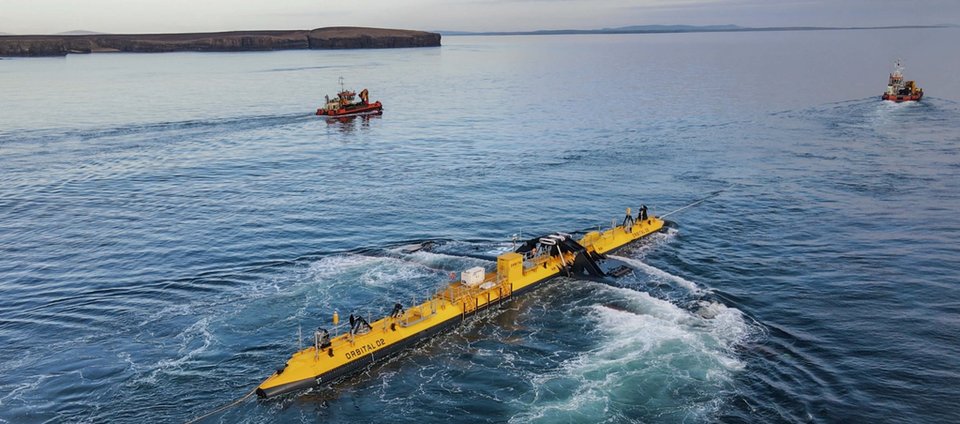Investment | Opinion
Tidal stream power: the UK's next renewables success story?
Government investment is needed to launch the next renewables energy success story, writes Miriam Noonan, analysis and insights manager at Offshore Renewable Energy Catapult.
Offshore wind has proven to be a very wise investment for the future of our planet. It is now a key pillar of UK energy policy and is leading the way in the energy transition. With this success fully mobilised, many investors are now looking for ‘the next big thing’ in renewables. One of the foremost candidates is tidal stream power.
Tidal stream technologies are well developed and validated, and the UK has a powerful first-mover advantage. The biggest names in tidal stream development are all UK based – Nova Innovation, Orbital Marine Energy and SIMEC Atlantis, to name but a few.
In 2018, we forecast that by 2030 tidal stream could yield a cumulative benefit to the UK of £1.4 billion and support almost 4,000 jobs, rising to 14,500 jobs by 2040. However, without the interim revenue support required for commercialisation of these technologies, this benefit for the UK could slip away.
We have the technical expertise within the UK to make this happen and we have the perfect geographic setting in which it can work, but the sector cannot get to market without the same government foresight and investment confidence afforded to wind.
The potential of tidal stream energy
The UK Government’s clean growth strategy sets out three tests to assess the viability of new forms of renewable energy, focusing on cost, the potential for the UK to lead the global market and impact on carbon emissions.
As the UK’s leading technology innovation and research centre for offshore renewable energy, we have found the answer to be resoundingly positive for every test.
UK tidal stream energy is already comparable with imported diesel and is on track to be cheaper than nuclear power (at £90/MWh once we reach 1GW) and possibly competitive with fossil fuels in the longer term.
Our potential to lead is clear given the concentration of tidal pioneers in the UK and the natural resource we have. Just by deploying current technologies in 30 key sites, tidal stream could supply 6GW of power – enough to power almost 5.6 million homes.
Tidal stream can be a complementary technology to wind and solar that will help balance the flow of power to the grid.
And when it comes to carbon reduction, marine energy technologies have the potential to reduce national emissions permanently by up to four million metric tonnes within 20 years.
What makes the case for tidal stream energy yet more compelling is its predictable nature. Wind and solar power have driven us towards our net-zero targets at an incredible pace, but they are not entirely predictable. When the wind blows or the sun shines is dependent upon the weather forecast, but the tides work to schedule. Tidal stream can be a complementary technology to wind and solar that will help balance the flow of power to the grid.
Our projects, such as the Interreg-funded €45m Tidal Stream Industry Energiser Project (TIGER), which is actively supporting the design, consenting or installation of up to 30MW of tidal stream capacity, are providing hard evidence for the viability and future profitability of this new sector.
Impressive tidal stream technologies, such as those used by Meygen in Scotland and those developed by Nova Innovation in Shetland, the world’s first grid-connected tidal stream array, have demonstrated incredible performance.
These projects have also far exceeded offshore wind’s UK content target of 60%: Nova Innovation and Orbital Marine have both achieved more than 80% UK content for site construction in their most recent installations. Nova Innovation has gone on to retain 98% UK content in its operational supply chain.

Orbital Marine’s O2 tidal turbine arrives at Orkney. Credit: TIGER
Government support will encourage investment
All new technologies need ‘launch aid’ to support early deployments prior to being fully commercial. Tidal energy is no exception. Private sector investment in tidal has stalled pending clarity on future government support. Many developers need that final investment push to get them over the line to full-scale deployment.
A government auction round – AR4 – is due to take place later this year. Offshore wind will be moved into its own pot, which is welcomed, but tidal stream energy must also be ring-fenced. The strike price will need to be high, reflecting the new and emerging technology, but as our data shows, that confidence now will reap rewards in the longer term.
We need to back this up with more frequent auction rounds, and we should consider new innovative methods of investment such as the Marine Energy Council’s proposed Innovation Power Purchase Agreement, which takes the resulting short-term, high-premium on strike prices away from consumer bills.
Offshore wind will continue to dominate the picture in terms of affordability, but tidal stream can compete with the cost of UK nuclear power and provide similar reliability and predictability.
With appropriate launch aid, costs of tidal stream energy could drop to below £90/MWh with the first 1GW of deployment, and we could realise a £25bn UK export opportunity. Beyond this we see progress with the potential to follow in the footsteps of offshore wind, which delivered projects at £125/MWh after the first 2.5GW of deployment.
In the long term, offshore wind will continue to dominate the picture in terms of affordability, but tidal stream can compete with the cost of UK nuclear power and provide similar reliability and predictability.
Tidal stream energy is on the launch pad, ready to become a key component of a cost-effective net-zero economy as well as a driver of economic recovery and growth in regions of the UK which could benefit the most.